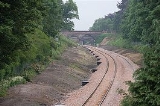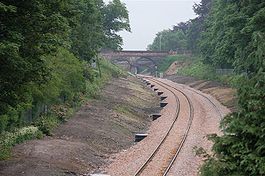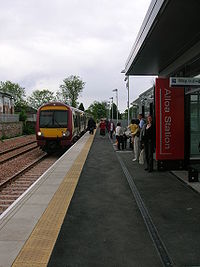
Stirling-Alloa-Kincardine rail link
Encyclopedia
The Stirling-Alloa-Kincardine rail link was a project to re-open 21 kilometres (13 mi) of railway line between the towns of Stirling
, Alloa
and Kincardine
in Scotland
, United Kingdom
. The route opened to rail traffic in March 2008.

funding and to relieve congestion
on the Forth Bridge
, the line between Stirling and Alloa has been reopened to passenger traffic. Construction work started in 2005, with track laying commencing at the end of September 2006 and ending in March 2007. In addition, the route required new signalling
, level crossing
s and a new Alloa railway station
.
Work was finished at the end of March 2008 and the line re-opened to the public on 19 May 2008, preceded by a series of pre-opening charters on 15 May 2008.
The line between Alloa and Kincardine has also been rebuilt to allow coal trains from Hunterston Terminal
, for example, to Longannet Power Station
to avoid using the Forth Bridge.
between Stirling and Alloa, and the Kincardine Line
between Alloa and Dunfermline along the north shore of the River Forth
past Longannet Power Station.
In addition to the track, the ballast was also renewed, and beneath that, waterproofing and soil reinforcing membranes were used, along with a great deal of new drainage. One major bridge, over the A907 at Helensfield, was completely renewed, with one new abutment to allow the road to be widened. Everything else was fully refurbished, and the steelwork of most of the bridges is now painted a distinctive maroon colour. The line as built is a single track, with passing loops at Cambus, to the west of Alloa, and Hilton, to the east. The new eastern bypass road passes over the Hilton loop on a bridge. The Cambus loop is to the east of the road into the village, while the original Cambus station was to the west. The passenger terminus at Alloa has a single terminal platform.
The line as built is a single track, with passing loops at Cambus, to the west of Alloa, and Hilton, to the east. The new eastern bypass road passes over the Hilton loop on a bridge. The Cambus loop is to the east of the road into the village, while the original Cambus station was to the west. The passenger terminus at Alloa has a single terminal platform.
The original loop at Kincardine has been removed, and to obtain a better alignment, the junction for the former power station sidings has been moved to the east, with a new locomotive run-round facility in the yard. The yard was used for supplies of track materials, ballast etc., but is also used as a coal loading point, so that coal from open-cast workings to the north can be transported by rail to Longannet
, without passing through the village of Kincardine. It was also used in conjunction with the construction of the adjacent Clackmannanshire Bridge across the River Forth.
Most of the level crossings on the route have been abolished. However several have been retained, where alternative access would be difficult and expensive to provide.
The line opened to regular passengers with the first timetabled train to Glasgow on Monday 19 May 2008.
, and some of the intermediate communities such as Clackmannan
, Kincardine, Culross
, Valleyfield or Cairneyhill
. The direct route from Alloa to Dunfermline is now partly obstructed by developments on the site of the old Dunfermline Upper station, and in particular there is no prospect of access to the existing Dunfermline Town (formerly Dunfermline Lower) station by that route; however, the Kincardine line gives direct access to Dunfermline Town.
There has been some discussion of the possibility of providing a service to Rosyth
Ferry Terminal.
In late April 2008, much of the coal freight heading for Longannet was transferred from the Edinburgh-Glasgow line via the Forth Bridge to the new railway.
Stirling
Stirling is a city and former ancient burgh in Scotland, and is at the heart of the wider Stirling council area. The city is clustered around a large fortress and medieval old-town beside the River Forth...
, Alloa
Alloa
Alloa is a town and former burgh in Clackmannanshire, set in the Central Lowlands of Scotland. It lies on on the north bank of the Firth of Forth close to the foot of the Ochil Hills, east of Stirling and north of Falkirk....
and Kincardine
Kincardine
Kincardine or Kincardine-on-Forth is a small town located on the north shore of the Firth of Forth, in Fife, Scotland. The town was given the status of a Burgh of barony in 1663. It was at one time a reasonably prosperous minor port...
in Scotland
Scotland
Scotland is a country that is part of the United Kingdom. Occupying the northern third of the island of Great Britain, it shares a border with England to the south and is bounded by the North Sea to the east, the Atlantic Ocean to the north and west, and the North Channel and Irish Sea to the...
, United Kingdom
United Kingdom
The United Kingdom of Great Britain and Northern IrelandIn the United Kingdom and Dependencies, other languages have been officially recognised as legitimate autochthonous languages under the European Charter for Regional or Minority Languages...
. The route opened to rail traffic in March 2008.

Background
Under Scottish ExecutiveScottish Executive
The Scottish Government is the executive arm of the devolved government of Scotland. It was established in 1999 as the Scottish Executive, from the extant Scottish Office, and the term Scottish Executive remains its legal name under the Scotland Act 1998...
funding and to relieve congestion
Traffic congestion
Traffic congestion is a condition on road networks that occurs as use increases, and is characterized by slower speeds, longer trip times, and increased vehicular queueing. The most common example is the physical use of roads by vehicles. When traffic demand is great enough that the interaction...
on the Forth Bridge
Forth Bridge (railway)
The Forth Bridge is a cantilever railway bridge over the Firth of Forth in the east of Scotland, to the east of the Forth Road Bridge, and 14 kilometres west of central Edinburgh. It was opened on 4 March 1890, and spans a total length of...
, the line between Stirling and Alloa has been reopened to passenger traffic. Construction work started in 2005, with track laying commencing at the end of September 2006 and ending in March 2007. In addition, the route required new signalling
Railway signalling
Railway signalling is a system used to control railway traffic safely, essentially to prevent trains from colliding. Being guided by fixed rails, trains are uniquely susceptible to collision; furthermore, trains cannot stop quickly, and frequently operate at speeds that do not enable them to stop...
, level crossing
Level crossing
A level crossing occurs where a railway line is intersected by a road or path onone level, without recourse to a bridge or tunnel. It is a type of at-grade intersection. The term also applies when a light rail line with separate right-of-way or reserved track crosses a road in the same fashion...
s and a new Alloa railway station
Alloa railway station
Alloa railway station is a railway station in the town of Alloa, Clackmannanshire, Scotland, which was re-opened on Monday, 19 May 2008.- History :...
.
Work was finished at the end of March 2008 and the line re-opened to the public on 19 May 2008, preceded by a series of pre-opening charters on 15 May 2008.
The line between Alloa and Kincardine has also been rebuilt to allow coal trains from Hunterston Terminal
Hunterston Terminal
Hunterston Terminal, in North Ayrshire, Scotland, is a coal-handling port located at Fairlie on the Firth of Clyde, and operated by Clydeport. It lies adjacent to Hunterston estate, site of Hunterston Castle....
, for example, to Longannet Power Station
Longannet power station
Longannet power station is a large coal-fired power station in Fife capable of co-firing biomass, natural gas and sludge. The station is situated on the north bank of the Firth of Forth, near Kincardine on Forth. Its generating capacity of 2,400 megawatts is the highest of any power station in...
to avoid using the Forth Bridge.
History of the route
The line uses the formation of the former Stirling and Dunfermline RailwayStirling and Dunfermline Railway
The Stirling and Dunfermline Railway was a railway in Clackmannanshire and Fife, Scotland connecting the stations in Stirling and Dunfermline. It had a branch line from Alloa to Tillicoultry.-Closure:...
between Stirling and Alloa, and the Kincardine Line
Kincardine Line
The Kincardine Line was a railway in Clackmannanshire and Fife, Scotland connecting the stations in Alloa and near Dunfermline along the north shore of the Firth of Forth. A short branch line ran from Charlestown Junction to Charlestown on the shore of the Forth...
between Alloa and Dunfermline along the north shore of the River Forth
River Forth
The River Forth , long, is the major river draining the eastern part of the central belt of Scotland.The Forth rises in Loch Ard in the Trossachs, a mountainous area some west of Stirling...
past Longannet Power Station.
Construction
Much of the remaining single track was still in place, but in very poor condition, and some sections had been removed, particularly at Kilbagie and near Blackgrange level crossing, so track laying was accomplished by conventional construction machinery such as bulldozers and excavators, rather than the rail-based equipment normally used for routine track replacement. Rail arrived by road in 60 foot lengths, was dragged from the nearest access point to its final position, and was then joined into continuous lengths by a mobile flash butt welding machine. This is a slow process compared to normal track renewal.In addition to the track, the ballast was also renewed, and beneath that, waterproofing and soil reinforcing membranes were used, along with a great deal of new drainage. One major bridge, over the A907 at Helensfield, was completely renewed, with one new abutment to allow the road to be widened. Everything else was fully refurbished, and the steelwork of most of the bridges is now painted a distinctive maroon colour.

The original loop at Kincardine has been removed, and to obtain a better alignment, the junction for the former power station sidings has been moved to the east, with a new locomotive run-round facility in the yard. The yard was used for supplies of track materials, ballast etc., but is also used as a coal loading point, so that coal from open-cast workings to the north can be transported by rail to Longannet
Longannet power station
Longannet power station is a large coal-fired power station in Fife capable of co-firing biomass, natural gas and sludge. The station is situated on the north bank of the Firth of Forth, near Kincardine on Forth. Its generating capacity of 2,400 megawatts is the highest of any power station in...
, without passing through the village of Kincardine. It was also used in conjunction with the construction of the adjacent Clackmannanshire Bridge across the River Forth.
Most of the level crossings on the route have been abolished. However several have been retained, where alternative access would be difficult and expensive to provide.
Route and potential alternatives
A deviation to the north to avoid the villages of Clackmannan and Kincardine was rejected as it would have cost many times as much as reopening the existing route. It would have used part of the Alloa to Dunfermline route, currently used as a cycle track and footpath, but would have required a tunnel in unknown and possibly problematic conditions in order to reach Longannet, and would have removed the possibility of providing stations at either Clackmannan or Kincardine in the future.Reopening
The line was formally reopened on Thursday 15 May 2008. The SRPS train, headed by 61994 The Great Marquess made four round trips from Alloa to Stirling, the first for VIPs, and the next three for paying passengers. All were fully loaded. As there are no run-around facilities for locomotives at Alloa, the return journeys were headed by a preserved Class 55 Deltic diesel locomotive, which remained attached to the Alloa end of the train throughout.The line opened to regular passengers with the first timetabled train to Glasgow on Monday 19 May 2008.
Usage
According to the Scottish Parliament, the usage was predicted to be 155,000 passengers per year, but part way through the first year this was revised upwards to 416,000, vastly exceeding the target.Future expansion
Adhering to the original route provides the possibility at a future date of providing passenger services to DunfermlineDunfermline
Dunfermline is a town and former Royal Burgh in Fife, Scotland, on high ground from the northern shore of the Firth of Forth. According to a 2008 estimate, Dunfermline has a population of 46,430, making it the second-biggest settlement in Fife. Part of the town's name comes from the Gaelic word...
, and some of the intermediate communities such as Clackmannan
Clackmannan
Clackmannan District 1975-96From 1975, Clackmannan was the name of a small town and local government district in the Central region of Scotland, corresponding to the traditional county of Clackmannanshire, which was Scotland's smallest...
, Kincardine, Culross
Culross
The town of Culross, pronounced "Coo-ros", is a former royal burgh in Fife, Scotland.According to the 2006 estimate, the village has a population of 395...
, Valleyfield or Cairneyhill
Cairneyhill
Cairneyhill is a small village in west Fife, Scotland. It is 3 miles west of Dunfermline, on the A994, and has a population of around 2,600.The village's architecture is a mix of old weavers' cottages and modern suburban housing estates. Most residents work either locally or commute to Edinburgh,...
. The direct route from Alloa to Dunfermline is now partly obstructed by developments on the site of the old Dunfermline Upper station, and in particular there is no prospect of access to the existing Dunfermline Town (formerly Dunfermline Lower) station by that route; however, the Kincardine line gives direct access to Dunfermline Town.
There has been some discussion of the possibility of providing a service to Rosyth
Rosyth
Rosyth is a town located on the Firth of Forth, three miles south of the centre of Dunfermline. According to an estimate taken in 2008, the town has a population of 12,790....
Ferry Terminal.
Driver training and commissioning
On 25 March 2008, the line became fully operational after signalling works over the Easter weekend to tie in the line to the existing network. On 31 March 2008, driver training began on the line to familiarise drivers with the route.In late April 2008, much of the coal freight heading for Longannet was transferred from the Edinburgh-Glasgow line via the Forth Bridge to the new railway.
External links
- Schematic map of the reopened line.

